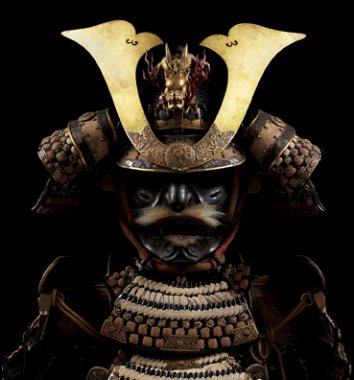The exceptional nucleus of armour, helmets and accessories of the Koelliker collection in Milan. The war-garments of the Samurai – the powerful military caste that ruled Japan for seven centuries – were always considered, even in peacetime, an important sign of authority and of social condition, leading to the creation of armour of amazing beauty, enriched by superbly crafted ornaments. The presence of these works is especially significant, since they are in keeping with Mariano Fortuny’s tastes; his collections also included ancient oriental weapons, with particular attention to Japanese art.
For seven centuries Japan was governed by a military caste – the bushi – or the class of the samurai – which left the emperor with a kind of priestly role as sovereign. The Samurai’s war-garments were always considered, even in peacetime, an important mark of authority and social condition. The powerful caste’s need to distinguish itself at times prevailed over the protective function of the amour, leading to the creation of armour of amazing beauty, enriched by beautifully crafted ornaments.
The Koelliker Collection of Japanese armour is almost unique in Europe for the number and quality of its items, and is undoubtedly one of the most important outside Japan.
The items come exclusively from high-ranking samurai, or from daimyo (feudal lords). The exhibition presents a selection of about eighty pieces, including complete sets of armour, helmets, sword-accoutrements and other samurai accessories, created between the Azuchi Momoyama period (1575 – 1603) and the Edo period (1603 – 1867).
In this last age lived legendary samurai like Miyamoto Musashi, the greatest master of the art of the sword, the protagonist of the novel by Yoshikawa Eiji, sold in over 120 million copies, inspiring at least fifteen film versions.
The samurai had the privilege of carrying two swords and of bearing a surname; they also had the right to “kill and go away” (kiritsuke gomen). After the spread of Buddhism in Japan the Samurai devoted themselves to techniques of meditation to acquire greater intuitive and cognitive powers, but also to eliminate fear and hesitation, to achieve total self-control, accepting the flow of events.
The exhibition makes it possible to admire extraordinary examples of tosei gusoku (“modern armour”) and to learn their history, constructive techniques, the main schools of arms-makers and to discover their various features (dô, menpô, kote, haidate etc).
The tosei gusoku substituted the ô-yoroi (literally “great armour”) of the medieval period, more manageable in battle, more resistant and comfortable. Conceived for war, it remained in fashion in peacetime as well, becoming an important symbol of social status. The display of coloured lacquers and bindings, the use of chiselled and gilded garnitures and ornaments and the continual search for unusual decorations are the defining characteristics of tosei gusoku armour.

